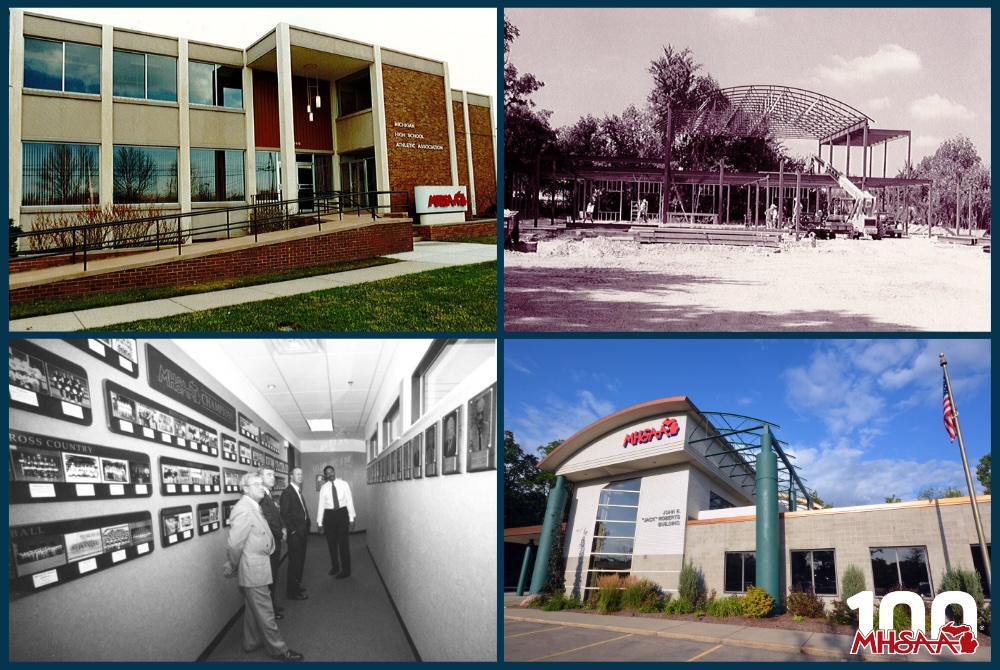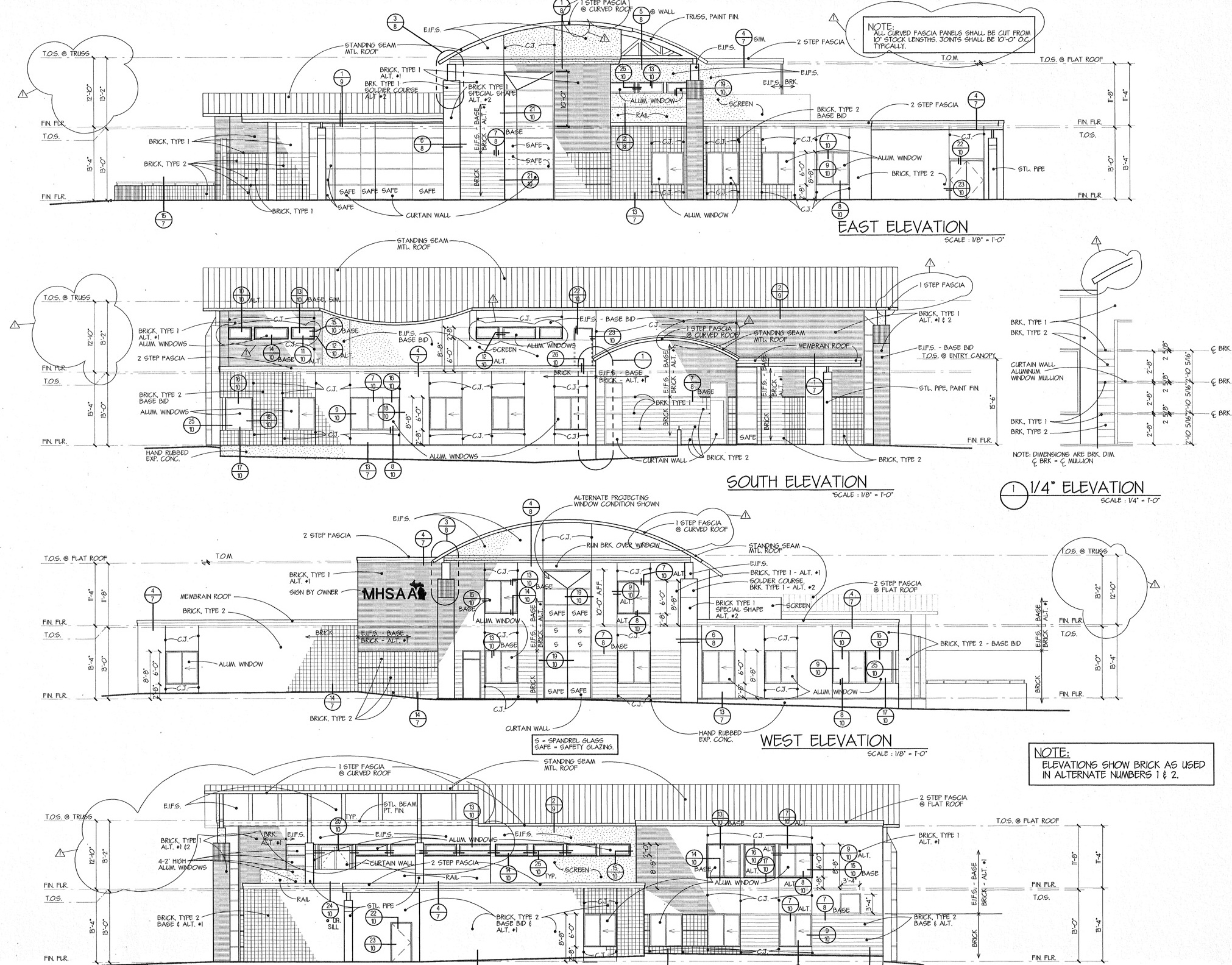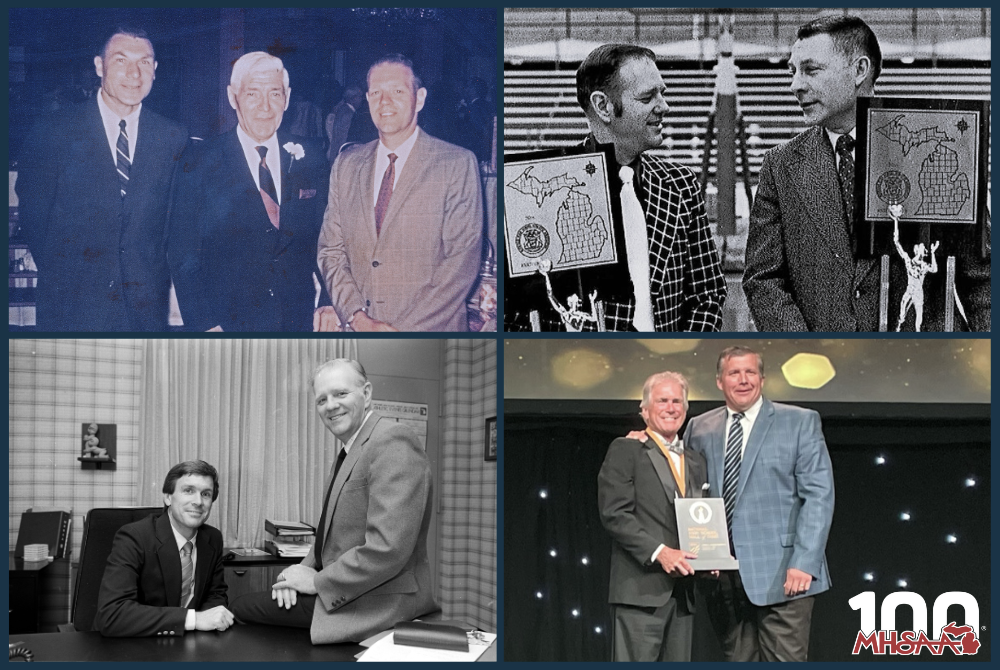
Century of School Sports: MHSAA's Home Sweet Home
By
Rob Kaminski
MHSAA benchmarks editor
November 5, 2024
Visitors to 1661 Ramblewood Drive for the multitude of MHSAA committee meetings, in-services and other functions are sure to see the faces of Michigan’s renowned educational athletics leaders throughout the years on various recognition boards.
Absent from any of those displays is the late East Lansing resident Thomas Reck. Yet, Reck and the long-range vision of Jack Roberts were equally as vital in “restructuring” the MHSAA in the late 1990s; quite physically.
“I really wanted something along US-127 – visible from 127 – and there was a good deal of open land where the building sits now that looked to be about the right size,” recalled Roberts, who at the time was just finishing the first decade of what would be an iconic 32-year run as the executive director of the MHSAA.
There was one potential roadblock to Roberts’ dream location: There was no indication of any kind that the property was for sale; no billboard, no realty listing.
That’s because it wasn’t for sale – yet.
“I contacted a realtor, Martin Property Development, and I suggested one of their employees call upon Mr. Reck,” Roberts said. “He did that, and got a purchase price of $600,000. To me, the excitement really took place before the first shovel went into the ground.”
The deal was then approved by both parties, and development began in 1996, with Reck’s residence remaining in place atop the small hill south of the new road leading to the proposed site of the MHSAA building.
“When we bought the land, there was no road,” Roberts said. “One of the reasons it curves is that Mr. Reck was given a life lease, so we had to go around his house. It also had to navigate some protected wetland areas.”
As for the name of the road, that was the MHSAA’s choice, one which actually came quite easily. The city of East Lansing had some concerns with the new development, and expanding on an existing name for the road was the first show of good faith by the newest tenants. Keeping the name Ramblewood made sense as there was already a Ramblewood Drive at the exact intersection to the east of Coolidge Road.
“We didn’t want to come in and change a lot of things, or inconvenience the residents in that area,” Roberts said. “We kept development back from the road and kept as much nature intact as possible. Even the signs that are there now are off the road and relatively small.”
Roberts and staff needed no signs to find their way to the new digs just more than three miles north of the previous offices on Trowbridge Road.
 Led by Roberts and former assistant director Tom Minter, much of the moving occurred during Christmas break of 1996. Doors to the new building were opened in January 1997, roughly seven years after Roberts first began dreaming of a new home.
Led by Roberts and former assistant director Tom Minter, much of the moving occurred during Christmas break of 1996. Doors to the new building were opened in January 1997, roughly seven years after Roberts first began dreaming of a new home.
The building on Trowbridge was formerly a credit union, and its structure provided some unique problems.
“In the late 1980s, around ‘88 or ‘89, we bought our first major computer, an IBM mainframe, and put it upstairs in the old building,” Roberts said. “It was about five feet high and eight feet wide and had its own room. We had to drill through concrete to wire it. I began to realize that we were going to have a hard time keeping up with things in a building that was so difficult to modernize.”
John Johnson, the MHSAA’s first communications director and a pioneer in that position among state high school associations, also reflected on the early days.
“Anything which was data-driven was jobbed out for awhile,” Johnson said. “Football playoff rankings were delivered to us once a week from a third party. We were doing everything outside the building: school databases, officials databases, penalty databases. The only thing we had inside the walls was word processing. I had the first PC in 1987.”
And, he recalled, the beast of a mainframe that took up an entire room at the expense of personnel. “Yep, it took up the whole room,” Johnson confirmed. “I was in what was called the library, which had historical books, but also old T-shirts left over from previous years’ champions.”
That lack of storage was also motivation for Roberts to find new real estate, and addressing that shortcoming was paramount in the plans.
“We had no storage, and no efficient way to receive shipments like rules books, paper, and the basic supplies we needed to run our business,” Roberts said. “That’s also why we have the lift in its current location at the new building; shipping and receiving were really important to us, along with our drop ceiling which made it much easier to run wiring as needed.”
As sparkling and expansive as the new facilities were, perhaps the best feature of all was its cost. The structure only took up a portion of the land purchased by the association, per Roberts’ vision. That left four parcels on the property for sale by the MHSAA, and with the road and utilities in place, those sections became even more valuable and enticing.
The MHSAA’s expenditures totaled roughly $1 million for the purchase of the land, road construction and utility installations. The parcels then sold for approximately $300,000 apiece.
“In the end, we had our space free of charge, and had $200,000 for furnishings,” Roberts said. The lone cost would then be the actual construction of the building, financed through a bond. And, the MHSAA could choose their neighbors, which was also part of the grand plan.
“We were going to be particular about who moved in, and that they’d be further back; not right on the road,” Roberts said. “Above all, we wanted to be good neighbors to the residents in the area and choose businesses that would be good neighbors as well.”
The other four parcels are occupied by medical practices, and the area remains a somewhat sleepy and hidden subdivision to this day.
Interestingly, and unknown to most, the MHSAA nearly held on to the parcel closest to its front door as a rental venture. That prospect led to spirited but friendly debate among Representative Council members at the time, leading to a vote on the matter of whether to sell the land or construct another building and rent space in that structure.
“There was good-natured discussion on the topic with arguments both in favor of selling and for building and renting on that last parcel,” Roberts said. “I remember on the morning of the vote, I offered the Council this to think about: We were really good at rules, really good at interpretations and administration of school sports. None of us were landlords or experts in that field.”
By a 10-9 vote, the Association would sell the final plot. “We didn’t get greedy, and history showed it was the right decision, what with the housing market landscape years later,” Roberts said. “We’d already won the lottery in a sense. Why enter into an area in which we knew little about?”
The timing of this new gem couldn’t have been any better, as the MHSAA was hosting the Section 4 meeting of state high school associations in September 1997. It was the perfect opportunity to showcase the facility with an open house attended by those in town for the meeting as well as current and former MHSAA staff and dignitaries.
Met with the now-recognizable and unique high-arching “roof” – half copper and half green, open frame – visitors were impressed. “The architect was on vacation in Florida and saw a similar building with the copper roof. When she assured me that it wouldn’t turn green over time, I agreed to do it,” Roberts said. “The design is actually still trendy, so it’s held up over time.”
Indeed it has, as verified by builders and designers currently giving the MHSAA’s home its first facelift.
“When I told people how old the building was, they couldn’t believe it, because its design has held up so well,” said MHSAA Assistant Director Dan Hutcheson, who has worked closely with contractors on building renovations during the last several months.
Even prior to this expansion and cosmetic overhaul, the MHSAA and its technology, staff were looking to the future.
 “Ironically, we upgraded projectors and cameras to delve into Zoom and virtual meetings before we really even knew what they were or how valuable they could be,” Hutcheson said. “This was winter of 2020, and a couple months later, Covid hits and by luck we’re kind of prepared, at least communication-wise.”
“Ironically, we upgraded projectors and cameras to delve into Zoom and virtual meetings before we really even knew what they were or how valuable they could be,” Hutcheson said. “This was winter of 2020, and a couple months later, Covid hits and by luck we’re kind of prepared, at least communication-wise.”
Following the Covid-19 pandemic, once the MHSAA was back on solid footing, Executive Director Mark Uyl began to outline and identify areas for expansion and updating inside the building.
Roberts’ foresight in the initial storage and expansion areas have paid huge dividends, as plenty of space existed for new offices.
The first meeting with architects post-pandemic was in September 2022, with renovations beginning in September 2023. Now, two years later, the project is near completion.
New color schemes, video boards, LCD displays and touchscreens serve to keep the facility in stride with those to which the MHSAA’s constituents have become accustomed.
There was plenty of work behind the scenes, too, such as fixtures and plumbing which simply had exceeded their lifespan or needed to be brought up to current codes. The overall mission for the changes, as always, was to better serve the membership.
“We serve 750 member schools, with so many from those schools coming here for training, teaching and educational sessions,” Hutcheson said. “As our staff members visit schools around the state, we see video boards, electronic message boards. We needed to keep in step with the schools, and in doing so, better assist our ADs, coaches and officials with their work.”
For two people who didn’t know one another, Reck and Roberts brought countless people together since 1997 to help them do their work.
Previous "Century of School Sports" Spotlights
Oct. 29: MHSAA Summits Draw Thousands to Promote Sportsmanship - Read
Oct. 23: Cross Country Finals Among MHSAA's Longest Running - Read
Oct. 15: State's Storytellers Share Fall Memories - Read
Oct. 8: Guided by 4 S's of Educational Athletics - Read
Oct. 1: Michigan Sends 10 to National Hall of Fame - Read
Sept. 25: MHSAA Record Books Filled with 1000s of Achievements - Read
Sept. 18: Why Does the MHSAA Have These Rules? - Read
Sept. 10: Special Medals, Patches to Commemorate Special Year - Read
Sept. 4: Fall to Finish with 50th Football Championships - Read
Aug. 28: Let the Celebration Begin - Read
PHOTOS (Top) Clockwise from top left: The former MHSAA office on Trowbridge Road. (2) Work is underway on the new MHSAA building on Ramblewood Drive. (3) The MHSAA office on Ramblewood before recent updates that included a switch from green to gray on the exterior. (4) Now-retired assistant director Nate Hampton, far right, and others walk the upstairs hallway of the recently-built Ramblewood building. (Middle) Blueprints for the Ramblewood office exterior. (Below) Past Executive Director Al Bush (right) and his wife, Lois, were on hand for the 1997 open house hosted by then-Executive Director Jack Roberts (left) and staff. (MHSAA file photos.)

Century of School Sports: Sharp Leadership Synonymous with MHSAA's Success
By
Geoff Kimmerly
MHSAA.com senior editor
April 2, 2025
Just as an organization often will rise and remain successful when there is consistent leadership, so is consistent leadership often a hallmark of a successful organization.
In celebrating a “Century of School Sports,” it’s no stretch to say the Michigan High School Athletic Association has been successful in its continued promotion and administration of educational athletics thanks in part to consistent excellent leadership in the form of only five fulltime executive directors, and two more directors who also took turns leading the organization through some of its most difficult moments.
Two of the MHSAA’s first four executive directors (who are retired, and therefore eligible for the honor) have been inducted into the National High School Hall of Fame by the National Federation of State High School Associations (NFHS). The first fulltime director – Charles E. Forsythe – became Michigan’s first Hall of Fame selection in 1983. The most recently-retired executive director – Jack Roberts – was selected in 2022.
All five executive directors have had monumental impacts on the direction of school sports in Michigan, not just during their time leading the MHSAA but in their various roles leading up to their service at the top of the organization. The below summaries do not come close to stating their full contributions, but merely some of the highlights for which they are most remembered:
Charles E. Forsythe (1931-42, 1945-68)
The MHSAA’s first fulltime executive director literally wrote the book on leadership of school sports programs – “The Administration of High School Athletics” was first published in 1939 and in five more editions as it became a popular college-level textbook. Previously an accomplished athlete, coach, official and athletic director, Forsythe joined the MHSAA staff in 1929 as an assistant director – and during his long tenure leading the office, school sports became part of the lifeblood of communities large and small all over the state. High school membership increased under his leadership, from 600 to 750 schools, and attendance for the MHSAA Boys Basketball Tournament – the headlining high school event of the day – increased from 126,000 for all rounds in 1930 to more than 775,000 at the time of his retirement. While advances were made in football and boys basketball, and in less-visible sports as well – all driving increased participation – the most notable work under Forsythe’s leadership made sports safer for all participants. Many of the most publicized safety initiatives came in football – including significant equipment requirements – but under his leadership the MHSAA in 1940-41 became just the second state nationally to add an accident benefit plan for participants. Forsythe died unexpectedly in December 1968, only a few months after his retirement. He is the namesake for the MHSAA’s annual lifetime achievement award.
Allen W. Bush (1968-78)
The MHSAA’s second fulltime executive director is the namesake for annual awards presented to contributors to school sports whose accomplishments are often behind the scenes and outside of the attention paid to championships and other high achievements. But Bush’s most-known accomplishments have received some of the greatest attention in MHSAA history, and deservedly so. During his tenure, the MHSAA added its first nine championship tournaments in girls sports, created the Football Playoffs and also began awarding Finals championships in baseball, ice hockey and skiing. Bush joined the MHSAA staff in 1960, serving under Forsythe as an assistant and then associate director.
Vern L. Norris (1978-86)
Norris, who died in 2018 at the age of 89, was known especially for his work with coaches and officials. He had coached at three high schools and was a tremendous official himself, having refereed the 1963 Class A Boys Basketball Final. The MHSAA’s annual Vern L. Norris Award honors an official who has been especially active in mentoring and training officials. Norris joined the MHSAA in 1963 and served under both Forsythe and Bush – the latter as associate director – also playing key roles in the creation of girls sports championships during the 1970s and expansion of those opportunities during the 1980s. He also played a significant role in rules-making nationally, contributing on several NFHS committees, and after leaving the MHSAA served as commissioner of the Great Lakes Intercollegiate Athletic Conference.
John E. “Jack” Roberts (1986-2018)
At the time of Roberts’ retirement, he was the nation’s longest-serving executive director – and with accomplishments in his state and nationally that were arguably unmatched. Under his leadership, the MHSAA grew more than 15 percent to more than 1,500 high schools and junior high/middle schools, and the state’s high school sports participation grew 10 percent and annually ranked higher than states with larger high school-aged populations. The MHSAA again became a national leader in health and safety, setting the pace in concussion care, heat management and CPR certification requirements and policies. The MHSAA also took national leads in coaches education and sportsmanship. Three girls sports and two boys sports were added to the tournament lineup during his tenure, as were 8-player football playoffs and an expansion of the 11-player tournament. Roberts had grown up studying the example of his father John, who served as executive director of the Wisconsin Interscholastic Athletic Association for 29 years, and Jack Roberts also served at the NFHS and Fellowship of Christian Athletes before taking over the MHSAA. Few have given their voice to school sports more prevalently: At the time of his retirement, Roberts had spoken in support of educational athletics in nearly every state and five Canadian providences.
Mark Uyl (2018-)
While his tenure as executive director has not yet reached a decade, Uyl already has steered the MHSAA through one of its most challenging times – the COVID-19 pandemic, which led to the cancelation of the end of the Winter 2019-20 season and all sports the ensuing spring. However, under Uyl’s direction – and while other states remained sidelined – MHSAA schools safely returned to activity during the fall of 2020-21, and despite delays completed their championship events for all three seasons that school year. Also a highly-respected game official on a national scale – and past coach and administrator in Michigan – Uyl joined the MHSAA staff in 2004 and has led the way as participation and officials registrations both have continued to rebound from significant decreases during COVID. His tenure also has seen the addition of an Individual Finals division for girls wrestling and the addition of girls field hockey and boys volleyball set for the 2025-26 school year.
Additional notes of recognition must be paid to two more leaders whose contributions came at some of the most delicate times over this successful century:
Julian W. Smith served as interim executive director while Forsythe served in the U.S. Navy during World War II. Smith – who had served on the MHSAA Representative Council for 10 years – received a three-year leave of absence from his role as principal at Battle Creek Lakeview High School and led the MHSAA through an unpredictable wartime era that included the cancelation of statewide championship events in boys basketball and track & field in 1943, but also their return a year later. He continued the promotion of physical fitness that was emphasized as a mission of school sports especially in preparation for service in the military, and during his time as executive director was named to the National Council of Physical Fitness.
Then there is Alden W. “Tommy” Thompson, perhaps the most influential yet forgotten leader in MHSAA history. Thompson had served on the Board of Control for the MHSAA’s predecessor organization, the Michigan Interscholastic Athletic Association (MIAA) and was then appointed as the first state director of interscholastic athletics, under supervision of the state superintendent and Michigan Department of Public Instruction, about three weeks before the official start of the MHSAA in December 1924.
Charles Forsythe credited Thompson with building the MHSAA “from scratch,” and legendary Lansing State Journal sports editor George Alderton praised Thompson for developing “an eligibility code that was positively fool proof,” classifying schools by enrollment to provide equal opportunities for small and large to win championships, organizing the state basketball tournament to make it financially beneficial to schools which in turn allowed them to spend to develop other sports, and giving a statewide stage to some of those less-visible sports including cross country, tennis and golf. Alderton wrote, “Tommy was the fellow who paved the way, ironed out the humps and gave the machine a push before the motor of popular interest began running.”
Forsythe served as Thompson’s assistant for two years before taking over as state director of athletics in 1931 as Thompson became the state director of physical and health education. However, both would lose their employment with the state’s department of public instruction in 1933 due to budgetary cuts – Thompson, to go on to several more pursuits in athletics, but Forsythe to remain as state director of athletics but now paid fully by the MHSAA, making him officially the association’s first fulltime executive director.
Previous "Century of School Sports" Spotlights
March 25: Athletic Directors Indispensable to Mission of School Sports - Read
March 18: 2025 Finals Begin Next Half-Century of Girls Hoops Championships - Read
March 11: Boys Basketball's Best 1st to Earn MHSAA Finals Titles - Read
March 5: Everything We Do Begins with Participation - Read
Feb. 25: Slogans & Logos Remain Unforgettable Parts of MHSAA History - Read
Feb. 19: MHSAA Tickets Continue to Provide Fan-Friendly Value - Read
Feb. 11: We Recognize Those Who Make Our Games Go - Read
Feb. 4: WISL Conference Continues to Inspire Aspiring Leaders - Read
Jan. 28: Michigan's National Impact Begins at NFHS' Start - Read
Jan. 21: Awards Celebrate Well-Rounded Educational Experience - Read
Jan. 14: Predecessors Laid Foundation for MHSAA's Formation - Read
Jan. 9: MHSAA Blazes Trail Into Cyberspace - Read
Dec. 31: State's Storytellers Share Winter Memories - Read
Dec. 17: MHSAA Over Time - Read
Dec. 10: On This Day, December 13, We Will Celebrate - Read
Dec. 3: MHSAA Work Guided by Representative Council - Read
Nov. 26: Finals Provide Future Pros Early Ford Field Glory - Read
Nov. 19: Connection at Heart of Coaches Advancement Program - Read
Nov. 12: Good Sports are Winners Then, Now & Always - Read
Nov. 5: MHSAA's Home Sweet Home - Read
Oct. 29: MHSAA Summits Draw Thousands to Promote Sportsmanship - Read
Oct. 23: Cross Country Finals Among MHSAA's Longest Running - Read
Oct. 15: State's Storytellers Share Fall Memories - Read
Oct. 8: Guided by 4 S's of Educational Athletics - Read
Oct. 1: Michigan Sends 10 to National Hall of Fame - Read
Sept. 25: MHSAA Record Books Filled with 1000s of Achievements - Read
Sept. 18: Why Does the MHSAA Have These Rules? - Read
Sept. 10: Special Medals, Patches to Commemorate Special Year - Read
Sept. 4: Fall to Finish with 50th Football Championships - Read
Aug. 28: Let the Celebration Begin - Read
PHOTOS Clockwise from top left: (1) Left to right, Al Bush, Charles Forsythe and Vern Norris take a photo together. (2) Norris, left, and Bush hold up Finals trophies. (3) Jack Roberts, left, stands with Mark Uyl during Roberts' induction into the National High School Hall of Fame. (4) Roberts, left, and Norris sit for a photo as Roberts began his tenure after Norris retired. (MHSAA file photos.)

